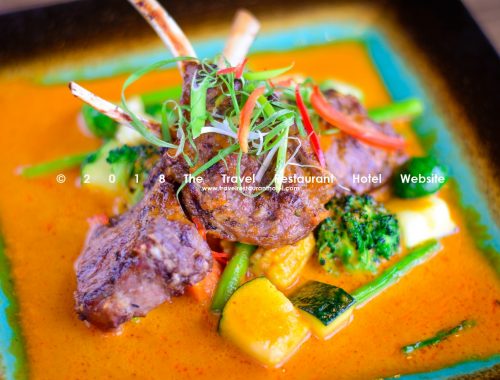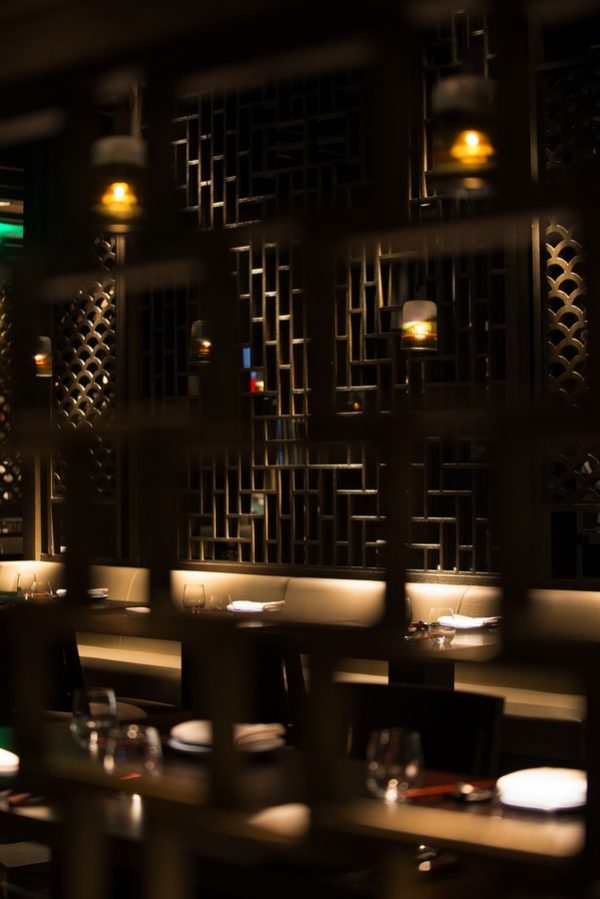Hakkasan, Shanghai
Housed at the iconic Bund 18 of Shanghai, Hakkasan Shanghai shines as a foremost Cantonese cuisine fine-dining establishment which excels in delivering multi-sensorial gastronomic experiences – stimulating the sight, sound, smell, touch and taste senses – to its esteemed guests.

With such an epicurean concept in mind, founder-restaurateur Alan Yau set out in 2001 to develop the globally renowned Hakkasan restaurant chain, which currently locates in 12 major cities of the world. Its unique Hakkasan blueprint manifests in an intoxicating blend of Chinoiserie design elements, artful lighting as well as carefully curated music and scents. It is this blend, collectively intertwined with its award-winning cuisine and inimitable mixology, which serve as the key success factors of the chain.
Amongst its higher accolades, Hakkasan Shanghai has been ranked as number 46 of Asia’s best 50 restaurants (published by William Reed Business Media) and awarded a Michelin star for its outstanding cuisine. Seeing that it is lauded to tick almost every box when it comes to dining experiences, I set out to verify this when I brought my anticipatory senses down to the Hakkasan Shanghai.
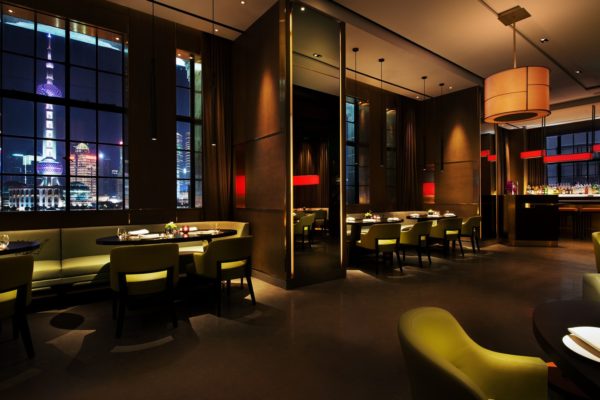
Upon arrival at the establishment, one was greeted by the maître d’ and asked if I would like to have some pre-meal drinks or commence with the meal first. Next, I was ushered to my dining table. Settling into my plush sofa seat, I felt myself relaxing even more, with the atmospheric Chi-relaxed sounds music permeating the environment. Glancing around, I noticed a striking array of lacquered lattice Chinese screens surrounding the dining room, lending an air of understated Chinoiserie charm to the restaurant. These were interspersed with theatre-like windows which yielded spectacular views of the city skyline and the Bund. This made for restful watching indeed.
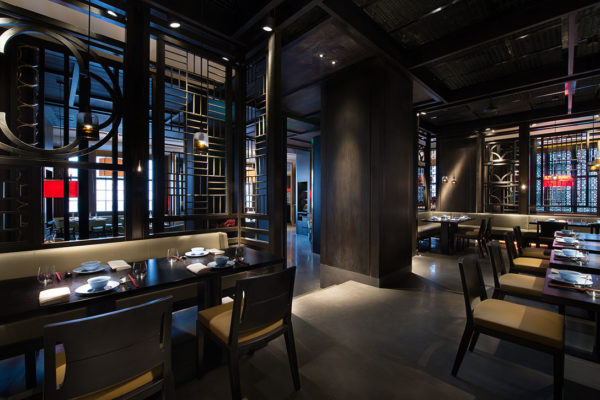
To me, service was of a relatively high standard – being unhurried, unobtrusive and quietly efficient. The staff were also well-versed in explaining the menus as well as making dish recommendations. Crockery were quickly cleared, empty teacups were attentively filled and dishes were served with proper decorum. The staff were even fashionably attired in Diane Von Furstenberg outfits. However, I did feel that good service should come with a smile, with a certain measure of warmth. That would be an area in which Hakkasan Shanghai should strive to improve on.
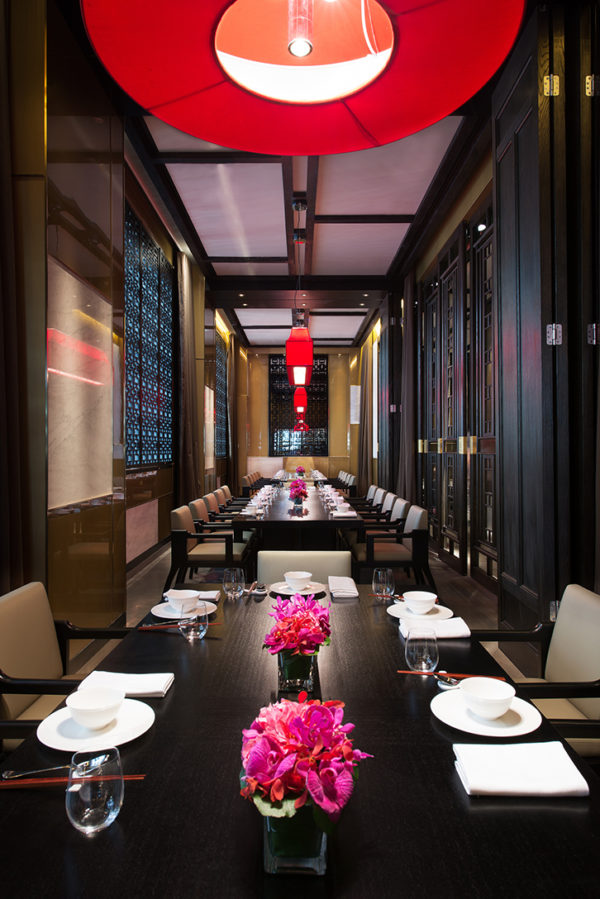
The Chinese cuisine offered at Hakkasan is characterised by authenticity and modern innovation, thus resulting in distinctive dishes that present an international perspective. According to executive head chef Tong Chee Hwee, they have a “menu philosophy of telling the story of China through reviving and modernising old recipes”. Furthermore, the wine program is arranged by body and flavours, customised to complement the Cantonese dishes on the menu and is administered by four wine sommeliers who can expertly serve in wine and food pairing.
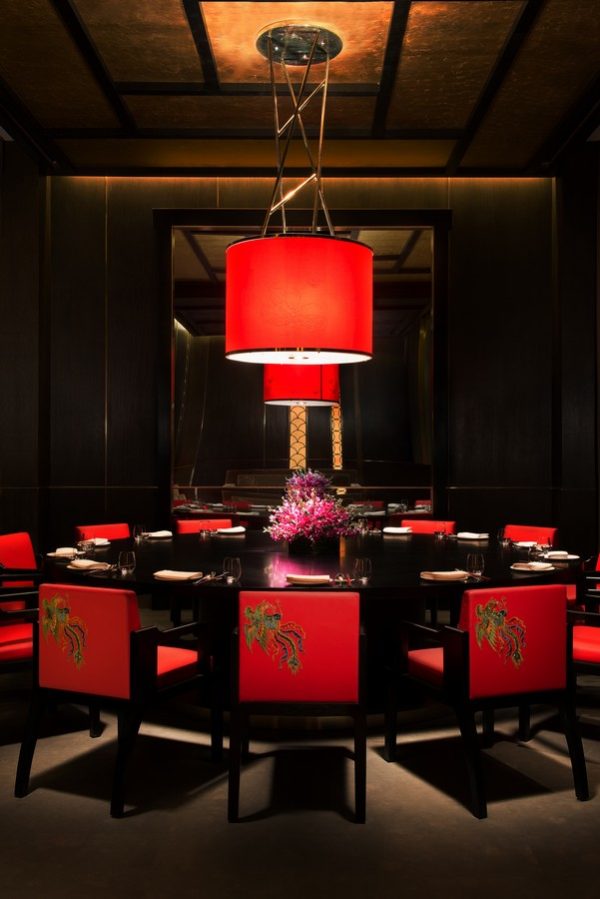
As a signature starter, we were recommended the Crispy Duck Salad, with Pomelo, Pine Nut and Pomegranate (RMB¥158). It came artistically arranged as a tower, with the duck meat meltingly tender inside and crunchy crispy on the outside. The 3 “P”s of pomelo, pine nut and pomegranate each infused the greens in a symphony of tastes that combined citrusy notes, nutty flavours and fruity zests together.
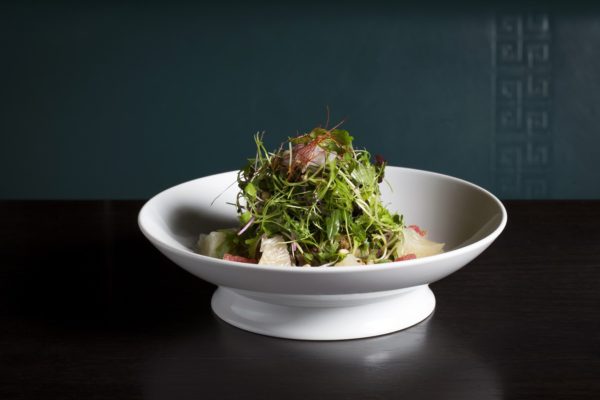
Dim sum is another trademark speciality of Hakkasan. I sampled this Luxurious Dim Sum Platter (RMB¥108) which has a delectably-hued selection of scallop siew mai, har gau (prawn dumpling), chive dumpling as well as roast duck and mushroom dumpling. With the exception of the last, the rest are bouncy and juicy, especially the har gau which is a burst of fresh flavourful shrimp.
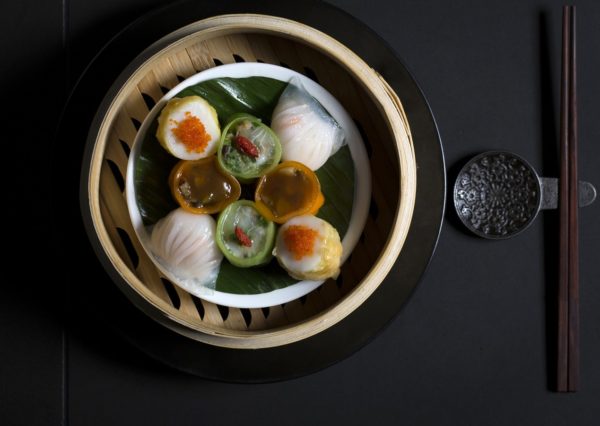
As for the Vegetarian Dim Sum Platter (RMB¥108), it comprises the morel crystal dumpling, steamed dumpling with autumn truffle, truffle pumpkin puff and cheese croquette. These dim sum, each cooked in variety of styles, represent the best of East-West fusion. The steamed dumpling and pumpkin puff both exude a rich truffle fragrance and full-bodied taste which blend well with the complementary ingredients within. The cheese croquette, fried to a crisp on the outside, has a chewy umami-tasting cheese centre.
Despite its eye-candy exterior, the Har Gau (shrimp dumplings) with Gold Leaf (RMB¥88), which came with slivers of foie gras within, did not gel well together. The flavours of each main ingredient seemed to register individually on the tastebuds, rather than as a whole.
The Black Pepper Roast Duck Dumplings (RMB¥38) scored above average on the taste register. It consisted of piquant flakes of savoury duck meat with hints of black pepper, not too overpowering, resulting in a well-balanced taste.

And finally, the crème de la crème of the dim sum – the steamed custard bun (RMB ¥33).
True to its nature, piping hot molten lava oozed out upon tearing a bun into half. Do blow gently on the contents before imbibing it. The lava gave a creamy smooth texture, with a delightful custard taste.

Pursuant to that, we moved on to sample a few specialties from the menu’s main course section.
The signature crispy duck with superior caviar cost the most at RMB¥688 for half a duck and RMB¥1288 for the whole duck. However, the merit of this dish is that it is two-in-one, meaning the first incarnation consists of crispy duck skin slices placed atop fresh pancakes and topped with caviar. The dish’s second incarnation comprises the interior duck meat, seasoned with a choice of XO sauce, black bean sauce or ginger and spring onion. This dish was well-worth its price, given its orchestra of multi-textured and layered tastes.
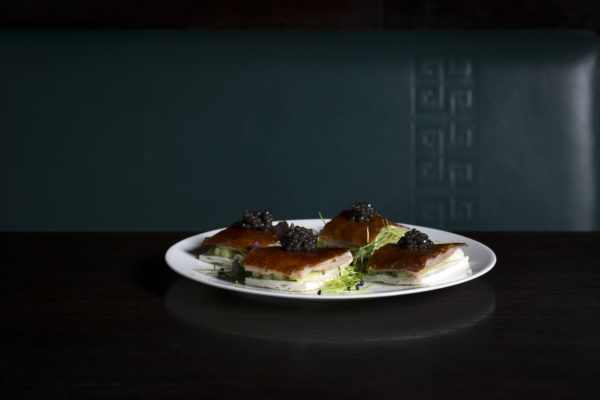
Another specialty is Roasted Silver Cod with Champagne and Honey (RMB ¥298). It is nicely roasted with an almost crisp outer shell, mildly marinated with champagne and hints of honey which serve to enhance its rich and almost sweet taste. The cod melted in my mouth marvellously. Placed in a moat of delicately flavoured fish broth simmered to perfection, it is sipped down to last spoonful.
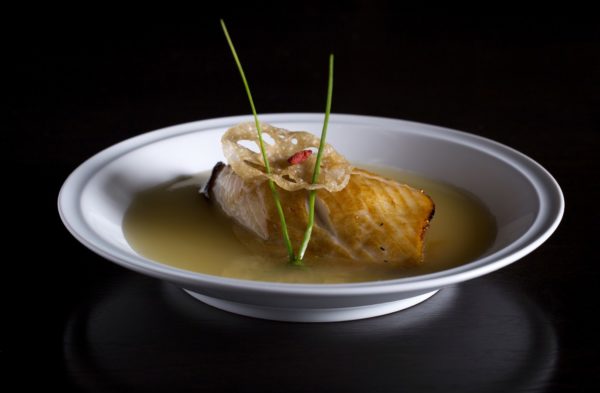
Finally, the last main course speciality we ate was Jasmine Tea Smoked Chicken (RMB¥118). The chicken thigh was deboned flawlessly, with the tender juicy meat imparting a smoky flavour.

My eyes feasted on the Lemon Pot (RMB ¥88) when it arrived. Thin shards of hard nougat, interspersed with blobs of meringue, circled an egg-shaped block of lemon curd with a lemon mousse base. It was interesting to eat all these elements separately as well as combining bits of each element on one spoon. This dessert was sweet, sour, tart, foamy and hard, all at once. Each part combined well to counterpoint another part – like the sweet meringue contrasting with the sour curd very well.
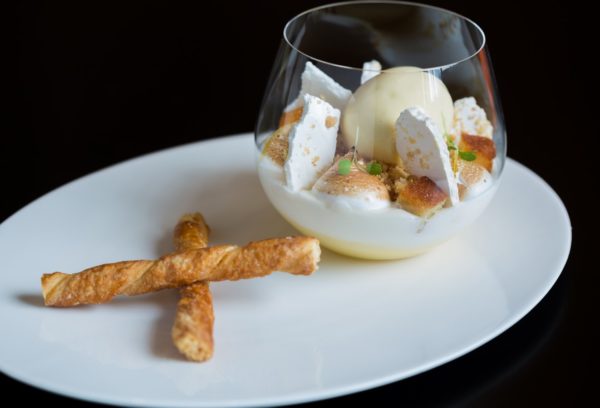
In summary, Hakkasan Shanghai with its exquisite Michelin-starred fare scores many more hits than misses for its multi-sensorial dining experiences, taking into account its outstanding wine program and mixology, stylish interior fittings, curated music, efficient service and spectacular views.
Moreover, a significant part of its menu of offerings can be had at relatively value-for-money prices, thus dispelling the notion that all fine-dining is always pricey. There are food gems to be discovered, even if one does not order the usual premium dishes. Having said that, it is a place to see and be seen, and is an ideal meal location for impressing important guests.
When all’s said and done, it is a remarkable experience to indulge in a feast for all your senses. If you happen to travel to the vicinity of the Bund, Hakkasan Shanghai is definitely well-worth a visit.
Hakkasan上海餐厅坐落于上海著名的外滩18号,是一家顶尖的粤菜精致美食馆,擅长于提供多感官美食体验 – 刺激视觉,听觉,嗅觉,触觉和味觉的感官 – 予其尊贵的客人。

带着这样的享乐主义观念,创始人兼餐厅老板丘德威于2001年开发出全球知名的Hakkasan连锁餐厅,目前位于世界的12个主要城市。其独特的Hakkasan蓝图体现在令人陶醉的中国风设计元素,巧妙的照明以及精心策划的音乐和香味的融合。正是这种融合,以及其屡获殊荣的美食和独特的调酒,作为Hakkasan成功的关键因素。
当中其较高的荣誉是Hakkasan上海餐厅已被列为亚洲最佳50家餐馆 – 排名46(由威廉·里德商业传媒出版) ,并以其出色的美食授予米其林星级。眼看就餐体验的评价几乎都是非常棒的,我充满期待地来到Hakkasan上海餐厅, 来验证这一切。

一踏入该餐厅,一位领班便上前来招呼我,问我是否想要一些餐前饮料或先用餐。接着,我被带到我的餐桌。坐在毛绒沙发座上,听着轻松的音乐, 我觉得自己放松更多,放眼四周,我发现周围的餐厅漆木点阵中国屏风的显着阵列,给餐厅添增一股低调的中国风魅力。这些与影院般的窗户穿插产生了壮观的城市天际线和外滩的美丽景色。这使人能宁静的欣赏。

对我来说,他们的服务水平是相当高的-不紧不慢,不显眼,静静地高效。工作人员也非常精通解释菜单以及推荐菜肴。餐具很快就被清除,空茶杯也被细心地填满而且都以适当的礼仪上菜。工作人员甚至还穿着时尚的黛安·冯芙丝汀宝的服装。但是,我也认为良好的服务应该是带着微笑,和一定程度的温暖。这是Hakkasan上海应该要努力提高之处。

Hakkasan提供的中国菜特点是真实性和现代的创新,从而研发出具有国际特色的菜肴。根据行政主厨童志辉(Tong Chee Hwee),他们有一个“菜单哲学”,就是通过把菜单的旧配方复兴和现代化来讲述中国的故事 。此外,上酒的程序是根据它的口感和味道来编排的,是由四位熟练地葡萄酒侍酒师为酒和食物配对,来陪衬菜单上的粤菜。

作为招牌开胃菜,我们被推荐沙律香酥鸭,里面还有柚,松子和石榴(人民币 158元)。它上桌的时候已被布置成有艺术气息的塔,里面的鸭肉非常嫩而外面则松脆香酥。柚,松子和石榴为蔬菜注入柑橘,坚果和水果的味道。

点心是Hakkasan的另一个特色佳肴。我品尝了它那豪华的点心拼盘 (人民币108元),其中有扇贝烧卖,虾饺 ,韭菜饺子以及烤鸭和蘑菇饺子。除了蘑菇饺子,其余的都有弹性和多汁,尤其是虾饺-非常具有鲜虾的美味

至于素食点心拼盘(人民币108元) ,它包括羊肚菌水晶饺子,秋天松露蒸饺,黑松露南瓜角和奶酪炸肉饼。这些点心,每一个都用不同的烹调方法,展现了东西合并的完美组合。该蒸饺和南瓜角都散发出丰富的松露香味和浓郁的味道,与其内的成分融合得恰到好处。至于奶酪炸肉饼,则炸到外面脆,中间却是耐嚼且有奶酪的鲜味。
尽管其外观养眼,虾饺与金叶( 人民币 88元) ,搭配上鹅肝条子,不是一个好配搭。各主要成分的味道似乎对味蕾分别注册着,而不能融合为一体。

黑胡椒烤鸭饺子( 人民币 38元)在味觉上得分高于平均水平。它包括美味鸭肉的辛辣片和黑胡椒的香气,不会太多太强,味道相当的平衡。 最后,最棒的点心 – 奶黄包( 人民币 33元) 。正由于它的性质,当一个奶黄包被撕裂一半后滚烫的熔岩会渗出。在吸液之前,记得要吹一下。熔岩使奶黄包具有奶油顺滑的质感,也有令人愉快的蛋奶味。

接着,我们继续品尝菜单上的一些特色主菜。招牌菜鱼子酱片皮鸭的价格最高,半只鸭为人民币 688元和全鸭为人民币1288元。然而,这个菜的优点是,它是二合为一体的,这意味着第一化身由上面摆放新鲜的煎饼和鱼子酱淋上脆皮鸭皮片。这道菜的第二化身包括内部鸭肉,可选择用XO酱,豆豉酱或姜葱做调味。就这道菜的多层次质感与口感而言,非常值得这个价格。

另一个特色佳肴是香槟蜂蜜烤银鳕鱼( 人民币 298元) 。银鳕鱼外皮被烤得刚好清脆, 加上它是用少许的香槟和蜂蜜腌制,这提升了它的浓郁和几乎有点儿甜的味道。鳕鱼在我的嘴里奇妙地融化了。放置在用慢火熬到完美微妙的调味鱼汤内,鱼汤是喝到一滴都不剩。

最后,我们吃的最后一道主菜特色佳肴是茉莉花茶熏鸡(人民币118元) 。鸡大腿已完美去骨,多汁的鸡肉也带有烟熏的味道。

我目不转睛地盯着刚呈上的柠檬锅(人民币88元)。硬牛轧糖薄碎片,加上酥皮的斑点点缀,围着蛋形块的柠檬凝乳和柠檬慕斯底。这些食材无论是分开吃,或者放在同一个勺子上一块儿吃都挺有趣的。这道甜点又甜,又酸,又硬,同时也有泡沫。每一样食材都搭配得很好 – 如甜酥皮与酸凝乳的对比非常好。

综上所述,Hakkasan上海餐厅以其精湛的米其林星级美食多感官就餐体验得分比扣分多,其中包括其出色的葡萄酒计划和调酒,时尚的室内装潢,音乐的策划,高效的服务和壮观的景色。
Hakkasan上海餐廳坐落於上海著名的外灘18號,是一家頂尖的粵菜精緻美食館,擅長於提供多感官美食體驗 – 刺激視覺,聽覺,嗅覺,觸覺和味覺的感官 – 予其尊貴的客人。

帶著這樣的享樂主義觀念,創始人兼餐廳老闆丘德威於2001年開發出全球知名的Hakkasan連鎖餐廳,目前位於世界的12個主要城市。其獨特的Hakkasan藍圖體現在令人陶醉的中國風設計元素,巧妙的照明以及精心策劃的音樂和香味的融合。正是這種融合,以及其屢獲殊榮的美食和獨特的調酒,作為Hakkasan成功的關鍵因素。
當中其較高的榮譽是Hakkasan上海餐廳已被列為亞洲最佳50家餐館 – 排名46(由威廉•里德商業傳媒出版) ,並以其出色的美食授予米其林星級。眼看就餐體驗的評價幾乎都是非常棒的,我充滿期待地來到Hakkasan上海餐廳, 來驗證這一切。

一踏入該餐廳,一位領班便上前來招呼我,問我是否想要一些餐前飲料或先用餐。接著,我被帶到我的餐桌。坐在毛絨沙發座上,聽著輕鬆的音樂, 我覺得自己放鬆更多,放眼四周,我發現周圍的餐廳漆木點陣中國屏風的顯著陣列,給餐廳添增一股低調的中國風魅力。這些與影院般的窗戶穿插產生了壯觀的城市天際線和外灘的美麗景色。這使人能寧靜的欣賞。

對我來說,他們的服務水平是相當高的-不緊不慢,不顯眼,靜靜地高效。工作人員也非常精通解釋菜單以及推薦菜餚。餐具很快就被清除,空茶杯也被細心地填滿而且都以適當的禮儀上菜。工作人員甚至還穿著時尚的黛安•馮芙絲汀寶的服裝。但是,我也認為良好的服務應該是帶著微笑,和一定程度的溫暖。這是Hakkasan上海應該要努力提高之處。

Hakkasan提供的中國菜特點是真實性和現代的創新,從而研發出具有國際特色的菜餚。根據行政主廚童志輝(Tong Chee Hwee),他們有一個“菜單哲學”,就是通過把菜單的舊配方復興和現代化來講述中國的故事 。此外,上酒的程序是根據它的口感和味道來編排的,是由四位熟練地葡萄酒侍酒師為酒和食物配對,來陪襯菜單上的粵菜。

作為招牌開胃菜,我們被推薦沙律香酥鴨,裡面還有柚,松子和石榴(人民幣 158元)。它上桌的時候已被佈置成有藝術氣息的塔,裡面的鴨肉非常嫩而外面則鬆脆香酥。柚,松子和石榴為蔬菜注入柑橘,堅果和水果的味道。

點心是Hakkasan的另一個特色佳餚。我品嚐了它那豪華的點心拼盤 (人民幣108元),其中有扇貝燒賣,蝦餃 ,韭菜餃子以及烤鴨和蘑菇餃子。除了蘑菇餃子,其餘的都有彈性和多汁,尤其是蝦餃-非常具有鮮蝦的美味

至於素食點心拼盤(人民幣108元) ,它包括羊肚菌水晶餃子,秋天松露蒸餃,黑松露南瓜角和奶酪炸肉餅。這些點心,每一個都用不同的烹調方法,展現了東西合併的完美組合。該蒸餃和南瓜角都散發出豐富的松露香味和濃郁的味道,與其內的成分融合得恰到好處。至於奶酪炸肉餅,則炸到外面脆,中間卻是耐嚼且有奶酪的鮮味。
儘管其外觀養眼,蝦餃與金葉( 人民幣 88元) ,搭配上鵝肝條子,不是一個好配搭。各主要成分的味道似乎對味蕾分別註冊著,而不能融合為一體。
黑胡椒烤鴨餃子( 人民幣 38元)在味覺上得分高於平均水平。它包括美味鴨肉的辛辣片和黑胡椒的香氣,不會太多太強,味道相當的平衡。

最後,最棒的點心 – 奶黃包( 人民幣 33元) 。正由於它的性質,當一個奶黃包被撕裂一半後滾燙的熔岩會滲出。在吸液之前,記得要吹一下。熔岩使奶黃包具有奶油順滑的質感,也有令人愉快的蛋奶味。

接著,我們繼續品嚐菜單上的一些特色主菜。
招牌菜魚子醬片皮鴨的價格最高,半隻鴨為人民幣 688元和全鴨為人民幣1288元。然而,這個菜的優點是,它是二合為一體的,這意味著第一化身由上面擺放新鮮的煎餅和魚子醬淋上脆皮鴨皮片。這道菜的第二化身包括內部鴨肉,可選擇用XO醬,豆豉醬或薑蔥做調味。就這道菜的多層次質感與口感而言,非常值得這個價格。

另一個特色佳餚是香檳蜂蜜烤銀鱈魚( 人民幣 298元) 。銀鱈魚外皮被烤得剛好清脆, 加上它是用少許的香檳和蜂蜜醃製,這提升了它的濃郁和幾乎有點兒甜的味道。鱈魚在我的嘴里奇妙地融化了。放置在用慢火熬到完美微妙的調味魚湯內,魚湯是喝到一滴都不剩。

最後,我們吃的最後一道主菜特色佳餚是茉莉花茶熏雞(人民幣118元) 。雞大腿已完美去骨,多汁的雞肉也帶有煙熏的味道。

我目不轉睛地盯著剛呈上的檸檬鍋(人民幣88元)。硬牛軋糖薄碎片,加上酥皮的斑點點綴,圍著蛋形塊¬的檸檬凝乳和檸檬慕斯底。這些食材無論是分開吃,或者放在同一個勺子上一塊兒吃都挺有趣的。這道甜點又甜,又酸,又硬,同時也有泡沫。每一樣食材都搭配得很好 – 如甜酥皮與酸凝乳的對比非常好。

綜上所述,Hakkasan上海餐廳以其精湛的米其林星級美食多感官就餐體驗得分比扣分多,其中包括其出色的葡萄酒計劃和調酒,時尚的室內裝潢,音樂的策劃,高效的服務和壯觀的景色。
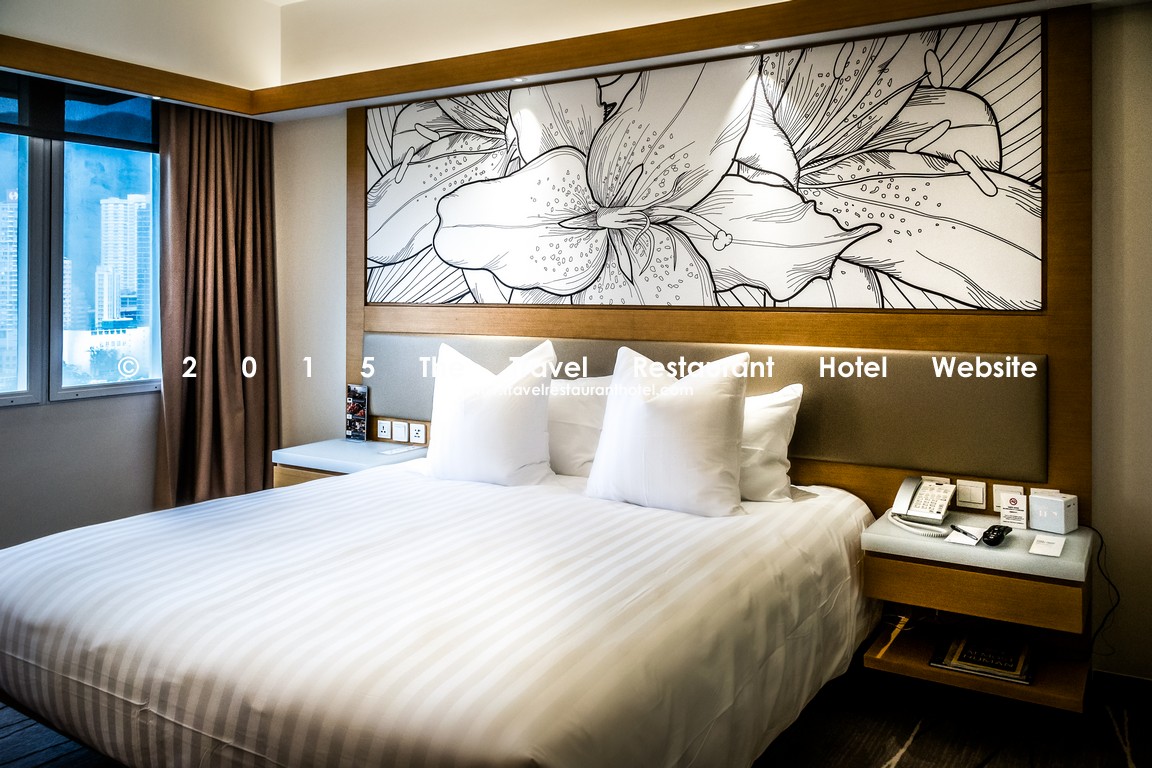
柏寧酒店, 香港 (繁體中文)
You May Also Like
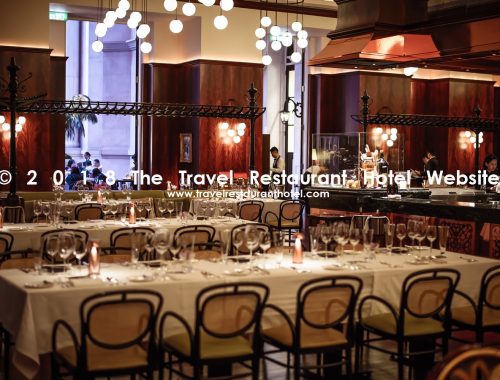
寶雅座 Aux Beaux Arts, 美高梅 MGM, 澳門 (繁體中文)
December 21, 2018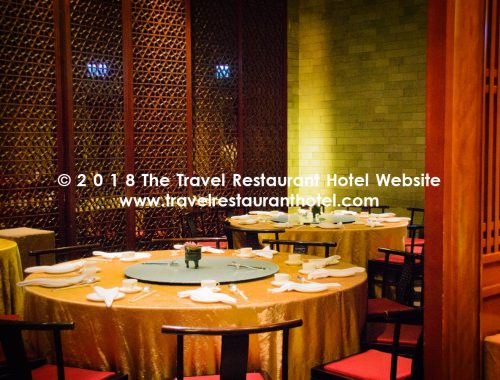
Kwan Cheuk Heen, 君绰轩, 香港 (简体中文)
November 22, 2018